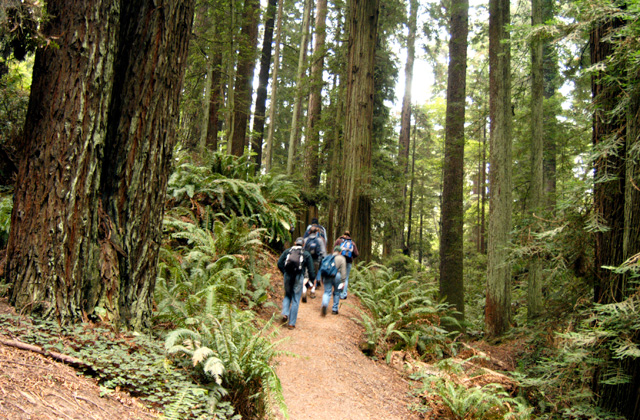
Environmental restrictions have by no means depressed the need for natural resource specialists. Exactly the opposite. The U.S. Department of the Interior and the Forest Service by themselves employ more than 90,000 people and they are retiring in droves—a 60% rate at the federal level. Rates at the state level run 40-50%. The mounting shortage of natural resource professionals is compounded by the fact that undergraduate enrollment in the field plunged 40% nationwide between 1995 and 2005.
Concurrently, workloads have grown heavier as environmental reviews multiply. The intensive labor they require affects all natural resource sectors, according to Lisa Perry, a student services staff member with HSU’s College of Natural Resources and Sciences, a long-time wellspring of career professionals.
Demand for HSU graduates is strong, as evidenced in the latest statistics tabulated by the Green Diamond Resources Company, a 118-year-old forest products firm that owns and manages timberland and lumber manufacturing facilities in Humboldt County. From January 1 until July 15 of this year, Green Diamond filled 43 management and technical positions and 31 of the new employees were HSU graduates and students. The list includes seven full-time forestry technicians, six of them HSU grads. Of five full-time resource technicians, four won their degrees from Humboldt State. The company also employed two registered professional foresters—again HSU alums—and currently is recruiting candidates for three forestry road technicians, an administrative forester, a timberlands operations analyst, two wildlife technicians, a laboratory technician and a production post.
“We have had a long-standing and highly successful relationship with HSU as a key source for recruiting both full-time and seasonal jobs in forestry, wildlife management and business management,” says Debi Callahan, Manager of the company’s Human Resources Department. “These employees are dedicated and committed to their professions and our community.”

HSU alum Megan Parker (’06) is a Forestry Technician with Green Diamond’s Klamath Operations. She partnered with the company on her senior forestry project, assisting with a public opinion survey. “Green Diamond knows how valuable environmental managers are and helps foster them through mentorship, training and diverse work experiences,” Parker reports. In her short time with the company—she signed on as soon as she graduated—she has progressed from a timber harvest plan layout to a focus on roads and hydrology. That is enabling her to round out her skills, and she hopes to qualify to take the Registered Professional Foresters Exam and become a Green Diamond forester.
The company’s need for natural resource expertise is broad, not only because of the extent of its California timberlands, but also because of the wide variety of wildlife species that lives on them, species that are an important part of each location’s ecosystem. Many of these timberlands are sites for the kind of state-of-the-art environmental experience that students in the College of Natural Resources and Sciences can pursue later in the job market.
Perry says the University is ideal for wildlife and forestry studies because of its unique natural location, which offers countless opportunities for hands-on, undergraduate field study of the kind Green Diamond conducts.
Beyond the company’s needs, career opportunities abound in both the private and public sectors: aquarium managers, botanists, environmental planners, restoration ecologists, forestry engineers, game wardens, hydrologists, soil and rock geologists, park rangers and interpreters, wildlife, fisheries and marine biologists, zoologists, rangeland managers, water quality technicians, GIS specialists (digital mapping) and firefighters and fire ecology.
“Fighting fires is a great way for a student to earn $20,000-plus per summer,” says Perry.
And HSU alum Parker emphasizes that the College of Natural Resources and Sciences enables students to branch out well beyond their majors, in her case forestry. She took a minor in environmental ethics and attended multiple fire classes. “It really is more fun when your homework has flames,” she jokes. “I also was able to take several Natural Resource Planning and Interpretation classes and the Schatz Tree Farm afforded me many field trips and practical skill building. Most of all, it was the professors who made me think, understand, ask questions and get out there. Graduating from HSU, I had a very broad range of knowledge and experiences.”
The public mistakenly believes that jobs associated with the natural resources sector are few and far between, but in fact demand is “screaming high” and will remain so well into the future, according to Perry. “We need professionals who can solve complex natural resource and environmental problems and come up with real solutions. They include using resources wisely and growing and harvesting sustainably. Professionals trained in California learn under the most stringent environmental protections in the world through the academic disciplines offered by our College of Natural Resources and Sciences.”
Perry underscores that today’s natural resource professions pivot on applied environmental science, helping society obtain the goods it needs while protecting habitat, preserving air and water quality and bolstering local economies.
For lovers of the outdoors, the jobs offer ideal locations to live and work—spacious forests and rangelands, streams, rivers, oceans, lakes.
Employers span the horizon, ranging from the Natural Resource Conservation Service and state and federal environmental protection agencies to the Farm Bureau, fish and wildlife agencies, forest product companies, the U.S. Park Service and land managers.